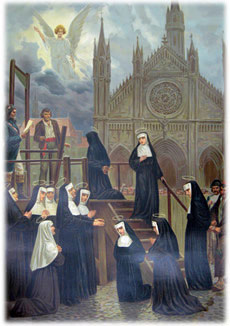ウルスラ会の11人の修道女の
ヴァランシエンヌでの殉教
1794年10月23日
|
Valenciennes |
Adult Catechesis & Christian Religious Literacy
in The Roman Catholic Tradition
Oct 23 – The Eleven Ursuline Martyrs
of Valenciennes, France d. 1794

フランス革命の政府当局に逮捕され、1794年10月の17日と23日にヴァランシエンヌでギロチン刑に処されたウルスラ会の11人の修道女たち。彼女らの罪状は、承認されていない教育機関が活動することを禁じた政府令に反して一つの学校を再開した事であった。修道女たちは以下の通り。
A group of eleven nuns of the Ursuline Order who were arrested by authorities of the French revolutionary government and guillotined between October 17 and 23, 1794, at Valenciennes. Their crime: they reopened a school in contravention to the government decree prohibiting unapproved educational institutions from functioning. The nuns were:
Sr Clotilde Paillot(長上)
Sr Marie Louise Ducret
Sr Marie Magdalen Desjardin
Sr Marie Louise Vanot
Sr Françoise Lacroix
Sr Margaret Leroux
Sr Anne Marie Erraux
Sr Anne Joseph Leroux
Sr Gabrielle Bourla
Sr Jane Louis Barré
Sr Jane Rievie Prin
Sr Clotilde Paillot, OSU, superior; Sr Marie Louise Ducret, OSU; Sr Marie Magdalen Desjardin, OSU; Sr Marie Louise Vanot, OSU; Sr Françoise Lacroix, OSU; Sr Margaret Leroux, OSU; Sr Anne Marie Erraux, OSU; Sr Anne Joseph Leroux, OSU; Sr Gabrielle Bourla, OSU; Sr Jane Louis Barré, OSU; and Sr Jane Rievie Prin, OSU.
長上であったクロチルド・パイヨ修女は全ての違法行為の責任を自分一人で負おうとしたが、法廷はそれを許さず、全員にギロチン刑を言い渡した。Marie Erraux 修女が恐怖で震え上がったので、クロチルド・パイヨ修女は彼女を慰め、支え、常に彼女の傍に居ることを約束した。
The prioress, Sr Clotilde Paillot, OSU, tried to take the entire blame on herself for any illegal actions but the tribunal refused to agree and all were condemned to the guillotine. Sr Marie Erraux, OSU was utterly terrified and Sr Clotilde comforted and supported her, promising to stay close beside her.
ヴァレンシエンヌはフランス領内にあったが、オーストリア領ネーデルラント(現在のベルギー)との国境に非常に近かった。革命政府は多くの修道会と学校を閉鎖した。ウルスラ会も例外ではなかった。所有物を差し押さえられ、没収され、立ち退かせられた彼女らは、国境を越え、ネーデルラントのモンスに向かった。その地のウルスラ会の別の修道会が彼女らに避難所を提供した。
Valenciennes is within the boundary of France but very close to the border of the Austrian Netherlands (present day Belgium). The Revolutionary government closed a larger number of religious houses and schools, including that of the Ursulines. Their property seized and confiscated, evicted, the Ursulines moved across the border to Mons in the Netherlands, where another Ursuline monastery gave them shelter.
1793年、オーストリアはオーストリア領ネーデルラントに対する主権を防衛するためにフランス北部に侵攻した。そうする中で、ヴァランシエンヌを含むフランスの領土を奪取した。それで、追放されていた修道女たちは今やオーストリア領となったヴァランシエンヌに戻り、彼女らの学校を再開した。しかし、フランスは報復してヴァランシエンヌを取り戻した。その時、気の毒な修道女たちはどうしたか。自分たちのホームグラウンド〔ヴァランシエンヌ〕に留まり、自分たちの学校を続けることに決めたのである。
In 1793 Austria invaded northern France to vindicate its sovereignty over the Austrian Netherlands. In doing so it also seized a strip of French territory that included Valenciennes. The evicted nuns therefore returned to Valenciennes, now Austrian, and reopened their school. But the French retaliated and recaptured Valenciennes. What were the poor nuns to do now? They decided to continue with their school in their old home.
その後ほどなく、フランス政府はヴァランシエンヌのウルスラ会修道女たちを逮捕し、投獄した。何の咎で? 彼女らは許可なしにフランスに戻ってきて不法に宗教学校を営んでいる移民である、として! 彼女らのうちの五人は1794年10月17日に裁判にかけられた。彼女らは率直に、自分たちはカトリック信仰を教えるために戻って来たのである、と述べた。しかし、それが犯罪と見なされ、彼女らは反キリスト教のフランス当局から死刑を言い渡された。
Shortly thereafter, the French government arrested and jailed the Ursulines of Valenciennes. On what charge? That they were emigrees who had returned to France without permission and were illegally conducting a religious school! Five of them were brought to trial on October 17, 1794. They stated frankly that they had returned to teach the Catholic religion. For this crime they were condemned to death by the anti-Christian French authorities.
修道女の一人、マリー・オーギュスティヌ・デジャルダン修女は、修母(この修母自身はこの時、まだ判決を受けていなかった)にこう言った。「ははさま、あなたは私たちに勇敢であることを教えて下さいました。そして今、あなたはお泣きになっていますが、私たちは冠を受けようとしているのです!」
One of the sisters, Sr Marie Augustine Dejardin, OSU, said to the mother superior (who had not yet been sentenced), “Mother, you taught us to be valiant, and now that we are going to be crowned, you weep!”
五日後、同じ長上マリー・クロチルド・パイヨ修女と他の五人の修道女たちは同じ方法で処刑される、という判決が下りた。パイヨ修母は公けの場で次のように宣言した。「私たちはカトリックの信仰のために、ローマの使徒的教会のために死にます!」。そして、犠牲者たちは死刑囚護送車(tumbril)として用いられていたダンプカート(dump-cart)に乗せられ、ギロチンまで運ばれた。
Five days later the same superior, Sr Marie Clotilde Paillot, OSU, and the other five nuns were condemned to die in the same manner. Mother Paillot made the public declaration, “We die for the faith of the Catholic, Apostolic Roman Church!” This time the victims were transported to the guillotine in a tumbril or dump-cart.
しかし、行政官たちは一人の修道女、コルドュール・バー修女を見落としていた。コルドュールは自分が仲間の修道女たちから切り離されることを望まなかった。彼女は急いでカートを追い、自ら進んでそれに乗り、そして他の修道女たちと一緒に処刑された。それら六人の修道女たちは、ギロチンの足場に向かいながら、声を合わせて聖母への連祷を歌った。それまでは内在的に過ぎなかった死に直面した時、カトリックの殉教者はどうするか? 歌うのである!
Now, the commissioners had overlooked a lay sister of the community, Cordule Barre. Cordule would not be separated from her sisters. Hurrying over to the cart, she climbed in of her own accord, and was executed with the rest. As they moved on to the scaffold, all six sang the Litany of Our Lady. What do Catholic martyrs do facing their immanent death? They sing!
聖母への連祷
Litany of Our Lady
〔翻訳省略。こちらを参照のこと〕
このような殺害に際しては、群衆は普通、それを娯楽とするために外に出て来て、冷やかしたり、侮辱の言葉を叫んだり、大いに騒ぐものである。しかし、この時は、修道女たちがギロチンまで引かれて来た時、群衆は静まり返った。クロチルド修女は兵士たちに感謝し、今日は自分たちの人生の中で最も美しい日である、と言った。彼女らは宗教的なシンボルを身に着けることを許されていなかったが、彼女は一つの十字架を隠し持っており、ギロチンの傍まで登った時、それを群衆に向かって投げた。
At these killings the crowd was usually out for entertainment jeering and shouting insults and making a great noise. But as the sisters were led to the guillotine the crowd fell utterly silent and still. Sr Clotilde thanked the soldiers, calling it the most beautiful day of their lives. They were not allowed any religious symbols, but she had hidden a crucifix on her person, and when she reached the guillotine, she threw it out into the crowd.
200年後、彼女らの死を記念する200年祭の祭典で、クロチルド修女の親族がその十字架をウルスラ会に渡し、殉教した修道女たちを記念するものとしてヴァランシエンヌの修道会の礼拝堂に保管することを頼んだ。
Two hundred years later, at a service commemorating the bicentenary of their death, the family of Sr Clotilde brought this crucifix to the Ursulines and asked them to keep it in the convent chapel at Valenciennes in memory of the martyred sisters.
この記事の最後の方に、クロチルド修女がギロチンの傍から群衆に向かって十字架を投げた、とありました。「十字架を投げるなんて、十字架を粗末にしている」とは考えないで頂きたい。彼女は誰かがそれを受け取ってくれると思っていたでしょう。そして、その通りに、それは彼女らの殉教の記念物となったのでした。
そして、これがその実際の十字架らしいです。
 |
 |
1794年10月にギロチンに処されたウルスラ会の長上クロチルド・パイヨ修母の銀の十字架。彼女は死ぬ前、ギロチンの足場〔やぐら〕のトップから、これを群衆に向けて投げた。… この十字架は、彼女の親族が、殉教者たちを偲ぶ200年祭が催された日(1994年10月22日)に、サン=ソルヴのウルスラ会に与えたものである。実際のサイズは 2.5cm ほど。
Croix en argent de Mère Clotilde Paillot Supérieure des Ursulines guillotinée en Octobre 1794. Avant de mourir, du haut de l'échafaud, elle la jeta dans la foule... Cette croix fut donnée par sa famille, à la Communauté des Ursulines de St Saulve le jour du Bicentenaire des Martyres le 22/10/94. Taille réelle s 2.5cm.
現代の私たちがカトリック書店の聖品売り場などで目にするものと大して変わりありません。先日した「写真」の話じゃないけれど、こういうのを見ると、彼女たちが思いのほか私たちに近い存在であることを感じます。
Internet Archive
“Les Ursulines de Valenciennes avant et pendant la terreur”(1901)by Loridan, J
amazon.fr
“Les Ursulines sous la Terreur : Un drame sanglant à Valenciennes”(1986)by Marc Theillier
CatholicSaints.Info
Hagiography Circle
Causes des Saints
「罪の概念は中世の哲学が聖書の内容を悲観的に解釈したものである、という考えを徐々に刷り込むことによって」